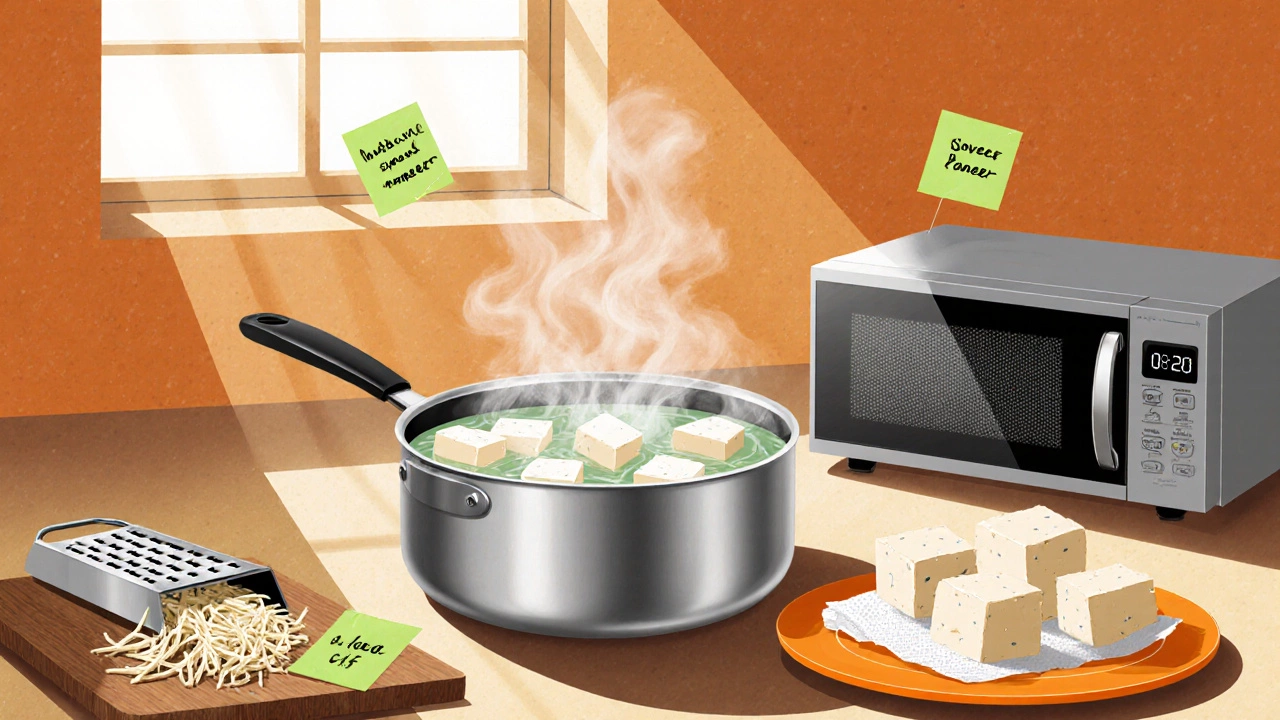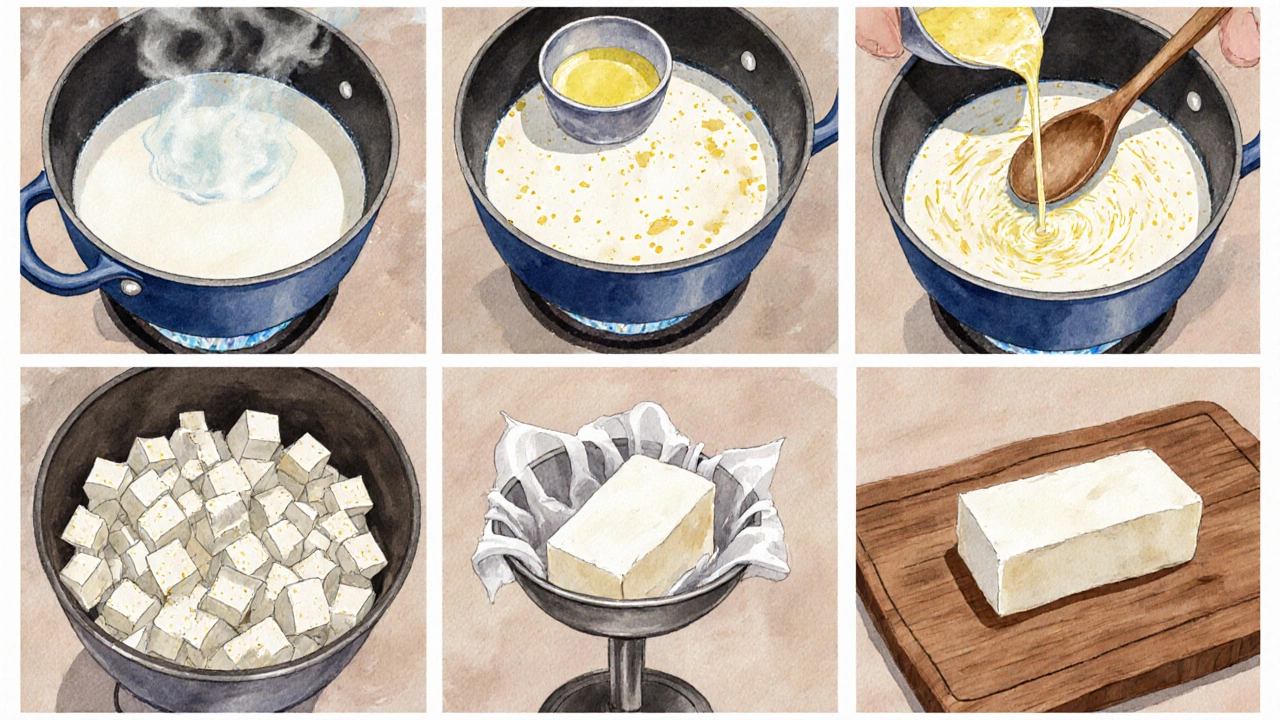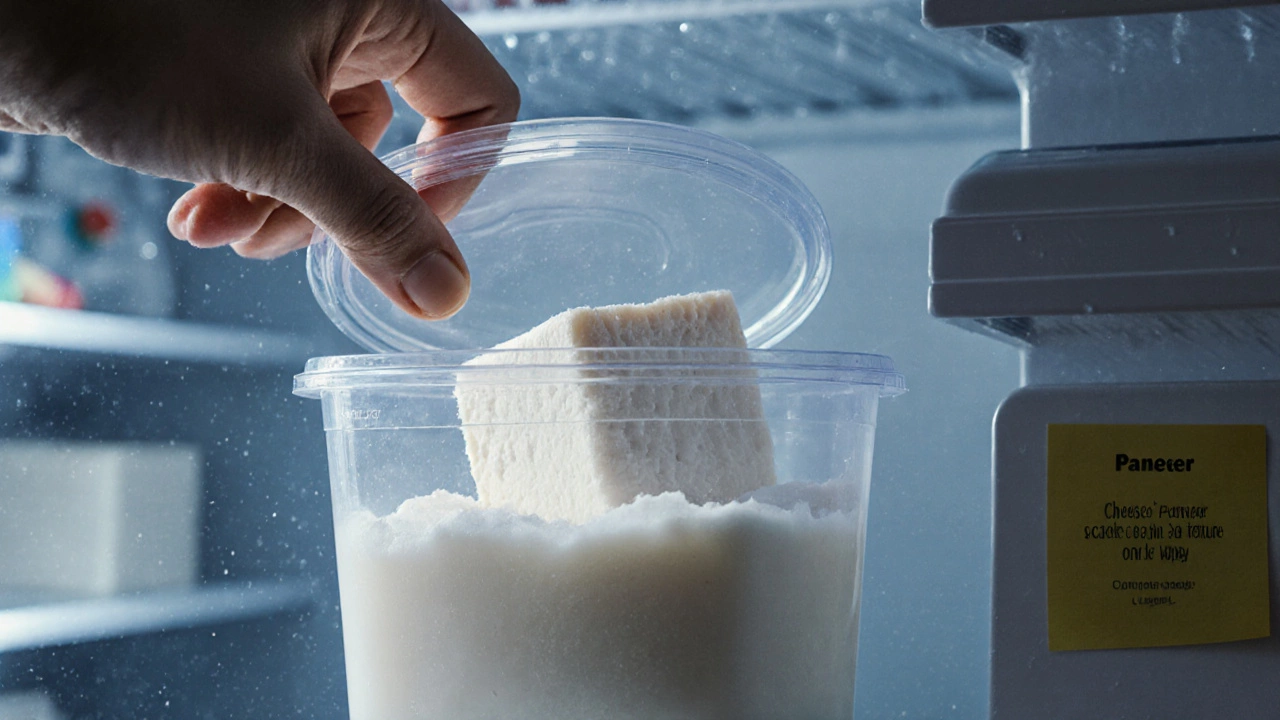Paneer Moisture Calculator
Paneer Type
Target Texture
Moisture Content
Recommendation
How to Adjust Moisture
When you know your paneer's moisture level, here are the best ways to adjust it:
- Store-bought paneer (low moisture): Soak in warm whey for 5-10 minutes to restore softness.
- Homemade paneer (high moisture): Lightly press for 15-30 minutes to reduce moisture.
- For desserts: Aim for 60-65% moisture with a soft whey soak.
Ever opened a pack of store-bought paneer only to find it feels like a rubber block? You’re not alone. Many home cooks wonder why the same cheese that’s supposed to be soft and milky turns into a chew‑chew experience. The answer lies in how it’s made, stored, and packaged. This guide breaks down the science, points out the usual suspects, and gives you practical tricks to soften that stubborn cheese-or make a better batch at home.
Key Takeaways
- Hardness in store-bought paneer is mainly caused by high heat, low moisture, and acidic or enzymatic coagulation.
- Packaging and storage conditions (refrigeration length, salt concentration) add to the firm texture.
- Simple kitchen tricks-soaking in warm whey, microwaving briefly, or grating-can bring back softness.
- Making paneer at home lets you control moisture, coagulation strength, and curd handling for a consistently tender result.
Paneer 101: What It Is and How It’s Made
Paneer is a fresh, non‑aged cheese common in South Asian cooking. It’s made by curdling whole milk with an acid (like lemon juice or vinegar) or an enzyme (rennet). The curds are then drained, pressed, and cut into blocks. Because it isn’t ripened, paneer retains a mild flavor and a firm yet crumbly texture when handled correctly.
Why Store-Bought Paneer Gets Hard
Commercial manufacturers aim for a product that lasts weeks on the shelf, travels well, and holds its shape during cooking. To meet those goals they often tweak three variables: heat treatment, moisture content, and coagulation method.
1. High Heat Pasteurization
Most brands pasteurize milk at temperatures of 85‑90 °C (185‑194 °F) for several minutes. While this kills pathogens, it also denatures whey proteins, causing them to bind more tightly to casein. The result is a tighter protein network that feels firmer.
2. Low Moisture Content
After curd formation, commercial producers press the curds harder and for longer periods to reduce water. A typical store-bought block may contain only 45‑50 % moisture, compared with 55‑60 % in a home‑made batch. Less water means less “give” when you bite.
3. Acid vs. Enzyme Coagulation
Acid coagulation (lemon juice, vinegar) creates a fine curd with a tighter mesh, while enzymatic coagulation (rennet or microbial rennet) produces larger curd particles and a softer bite. Many factories favour acid for its speed and consistency, which inadvertently contributes to hardness.
4. Salt and Preservatives
Adding salt-sometimes up to 2 % of the cheese weight-helps with shelf life but also draws out water through osmosis. Some brands also sprinkle calcium chloride to improve firmness, which again reduces softness.
5. Packaging Atmosphere
Vacuum‑sealed or airtight plastic tubs limit moisture loss but also trap any residual acidity. Over time, the low‑pH environment promotes protein tightening, especially if the cheese sits in the fridge for more than a week.
Store‑Bought vs. Homemade: A Quick Comparison
| Attribute | Store‑Bought | Homemade |
|---|---|---|
| Moisture (%) | 45‑50 | 55‑60 |
| Coagulation | Acid (lemon/vinegar) or fast‑acting rennet | Acid (lemon) or slow‑acting rennet, optional |
| Pressing Time | 30‑60 min, high pressure | 15‑30 min, light pressure |
| Salt Level | 1‑2 % (w/w) | 0‑0.5 % (optional) |
| Shelf Life | 2‑3 weeks (refrigerated) | 3‑5 days (refrigerated) |
| Texture | Firm, sometimes rubbery | Soft, crumbly, melt‑in‑mouth |

How to Test Paneer Hardness at Home
- Press gently with a fingertip. If it yields with a slight give, it’s still soft.
- Snap a small piece. A clean snap without shattering indicates moderate firmness; a crumbling snap means it’s too dry.
- Dip a corner in warm water (40‑45 °C). If it softens within 30 seconds, moisture is adequate.
Simple Tricks to Soften Store‑Bought Paneer
When you’ve already bought the hard block, these kitchen hacks can rescue it for curries, grills, or desserts.
- Warm whey soak: Heat a cup of whey (or milk water) to just below boiling, add the paneer cubes, and let them sit for 5‑10 minutes. The whey’s residual lactose and protein help re‑hydrate the cheese.
- Microwave melt: Place sliced paneer on a microwave‑safe plate, cover with a damp paper towel, and heat for 15‑20 seconds. The steam adds moisture.
- Grate it: Grating creates thin shreds that absorb sauces better, masking any residual chewiness.
- Salt‑water bath: Submerge the block in a lukewarm brine (½ % salt) for 10‑15 minutes. The mild salt solution restores some flexibility without making the cheese overly salty.
- Cook with sauce early: Add paneer to the curry at the start of simmering, letting it soak up liquid for 5‑7 minutes before the final boil.
Make Your Own Soft Paneer: Step‑by‑Step
Controlling the variables is the easiest way to guarantee a tender result.
- Choose the right milk: Full‑fat milk (≥3.5 % fat) provides the best creaminess. Avoid ultra‑high‑temperature (UHT) milk; it already has a tight protein network.
- Heat gently: Warm the milk to 85 °C (185 °F) and hold for 2 minutes. Stir constantly to prevent scorching.
- Add coagulant: Mix 30 ml of fresh lemon juice per litre of milk, or use 1 g of liquid rennet diluted in 30 ml water. For a softer curd, use a slightly lower acidity (lemon juice) and let the curd set for 10 minutes.
- Cut the curd: Once the whey separates, cut the curd into 2‑cm cubes. This releases trapped whey without breaking the curd too much.
- Drain and lightly press: Line a colander with cheesecloth, pour the curds, and let drain for 10 minutes. Then gather the cloth and place a light weight (≈200 g) for another 10 minutes. You’ll end up with about 55‑60 % moisture.
- Season (optional): Sprinkle with a pinch of salt if you plan to store for more than a day. Keep the block in its whey, refrigerated, for up to 4 days.
Tip: If you prefer a slightly firmer block for grilling, press for 30 minutes with a heavier weight. For salads or desserts, stop at the 10‑minute light press.

What to Look for When Buying Paneer
If you must buy, check the label for clues that indicate a softer product:
- Moisture‑rich wording: “fresh,” “soft,” or “with whey.”
- Low salt content (≤0.5 %).
- Absence of additives like calcium chloride.
- Packaging that includes a small amount of liquid (whey) rather than a dry block.
Preventing Hardness in Your Own Production
For small‑scale producers or avid home chefs who stock paneer in the freezer, these steps keep it from turning rubbery:
- Freeze in whey: Store cubes in their own whey in airtight bags. The whey acts as a natural cryoprotectant.
- Limit freezing time: Use within 2‑3 months; longer storage encourages protein crystallization.
- Thaw gently: Move frozen paneer to the fridge overnight, then soak in warm whey for 5 minutes before cooking.
Mini FAQ
Why does my store‑bought paneer taste sour?
Many brands add a small amount of citric acid or use a higher‑acid coagulant to speed up curding. Over time, this leftover acidity can give the cheese a faint sour note, especially after a week in the fridge.
Can I substitute yogurt for lemon juice when making paneer at home?
Yes. Yogurt provides lactic acid, which gently curdles milk. Use about 100 g of plain yogurt per litre of milk and let it sit for 15‑20 minutes before heating. The result is a creamier, slightly tangier paneer.
Is it safe to eat paneer that’s a few days past the printed date?
If the cheese has been kept continuously refrigerated, shows no off‑odor, and still feels moist, it’s generally okay for another 2‑3 days. Always trust your senses before consuming.
What’s the best way to melt paneer for a smoothie or dessert?
Blend softened paneer (after a quick warm whey soak) with milk, a pinch of cardamom, and a sweetener. The high moisture content after soaking ensures a smooth texture without graininess.
Can I use low‑fat milk to make paneer?
You can, but the final cheese will be drier and crumbly. Adding a tablespoon of cream or a splash of whole‑milk powder compensates for the lost fat.
Now you know why that grocery‑store block sometimes feels more like chewing rubber than fresh cheese, and you have a toolbox of fixes-both quick hacks and full‑on paneer‑making. Whether you’re whipping up a creamy tikka masala or a sweet rasgulla, the right texture makes all the difference.
